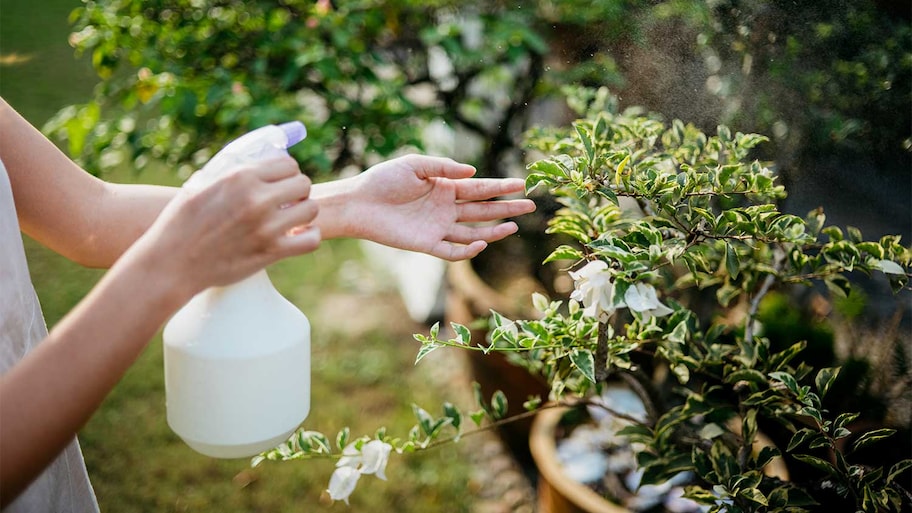Highlights
Powdery mildew is a very common fungal disease that affects most plants.
Plants like squashes and begonias are more susceptible than others.
Leftover mold spores, certain weather patterns, and a lack of enough sun, airflow, and nutrients can encourage outbreaks.
Inspect plants regularly during late spring and early summer to look out for this disease.
The sooner you treat it, the easier it is to eradicate.
For treatments, try mixtures with baking soda, milk, or neem oil.
Some of your plants look like they’ve been sprinkled with baby powder. Or maybe their leaves have browned, yellowed, or dropped to the ground. The culprit for these pesky symptoms is most likely powdery mildew, an extremely common fungal disease. Although it’s rarely fatal, it can stunt plant growth, reduce flowering, and decrease crop yields. Read on to learn the causes of this condition, plus tips on prevention and treatment.
How to Identify Powdery Mildew
If powdery mold has infiltrated your garden, look on the bright side: it’s a pretty easy disease to spot and diagnose. This is a good thing because the sooner you treat it, the easier it is to get rid of.
Typically, the disease begins with a few small white or gray spots (spores) on leaves. These then spread, eventually coating leaves and sometimes stems and buds. Infected buds won’t open. Instead, they’ll dry out on the plant and sometimes fall off.
What Plants Get Powdery Mildew?
While all plants can get sick, some (including the varieties listed below) are more susceptible than others. Here are a few plants that most commonly suffer from powdery mildew infection:
Fruit: Apples, grapes, melons, strawberries
Vegetables and legumes: Beans, cucumbers, lettuce, parsley, peas, peppers, potatoes, tomatoes, squash
Flowers: Begonias, roses, zinnias, sunflowers, dahlias, hydrangeas, chrysanthemum, peonies, and garden phlox
When shopping for a type of plant (like cucumbers), seek out more resistant varieties. Also consider pulling out plants that repeatedly succumb to the disease.
Ways to Prevent Powdery Mildew From Infiltrating Your Garden
Certain factors up the odds your plants will come down with the disease. Consider how you set up and maintain your garden when looking for ways to prevent powdery mildew.
1. Discard Leftover Spores
Powdery mildew mold spores can last over the winter in leaf piles and on plants, spreading the condition come spring. So, ask your local landscaper to remove and discard (not compost) any infected leaves, stems, buds, fruits, or vegetables (trim some perennials with particularly bad cases down to the ground).
Also, disinfect any gardening tools that touched diseased plants and try rotating annuals and vegetables. By switching around your plants from year to year, you’ll disrupt the parasite’s life cycle.
2. Leverage the Sun
If you plant sun-loving varieties in the shade, they’re more likely to come down with powdery mildew. If you can, move them to a sunnier spot.
3. Pack in the Nutrients
To keep plants healthier, apply slow-release fertilizer regularly. Don’t use fast-acting synthetic fertilizers, which can lead to lots of new growth at once (new growth is particularly prone to the disease).
4. Improve Airflow
Poor air circulation around plants can lead to powdery mildew. To boost airflow, space plants apart from each other and far from walls and fences. Cultivate beans, cucumbers, and vining squash plants on trellises, to keep them off the ground. Thin out plants, especially varieties more susceptible to the disease.
5. Pay Attention to the Weather
Late spring and early summer, with their warmer days and cooler nights, can be prime times for this disease to hit. Temperatures between 60 and 80 degrees Fahrenheit also increase plants' chances of coming down with a case. To best navigate these weather conditions, inspect plants regularly and spray foliage daily with a hose in the morning. This way, they can dry before cooler evenings hit.
How to Treat Powdery Mildew on Plants

While no treatments are guaranteed cures, many are quite effective. To pick the best one, bring an infected leaf or a photo of the damage to your local garden center. Ask an expert which one they recommend.
No matter the solution, spray on all plant surfaces, including stems, buds, tops, and bottoms of leaves. Apply once a week for three or four weeks, wait, then reapply if you still see symptoms.
Milk: To prevent and treat plants, combine one part milk with three parts water in a spray bottle.
Powdery mildew fungicide: To prevent and treat plants, try a sulfur-based product. Don’t use more than the directions advise, since too much can harm plants.
Neem oil: More of a preventative, mix this commercially available natural fungicide into a spray. Water plants, then apply. Wait at least two weeks to use if you sprayed with sulfur-based fungicide recently.
Baking soda mixture: For another preventative, combine 1 tablespoon baking soda (or potassium bicarbonate), ½ teaspoon liquid soap (not detergent), and one gallon of water in a spray bottle.





